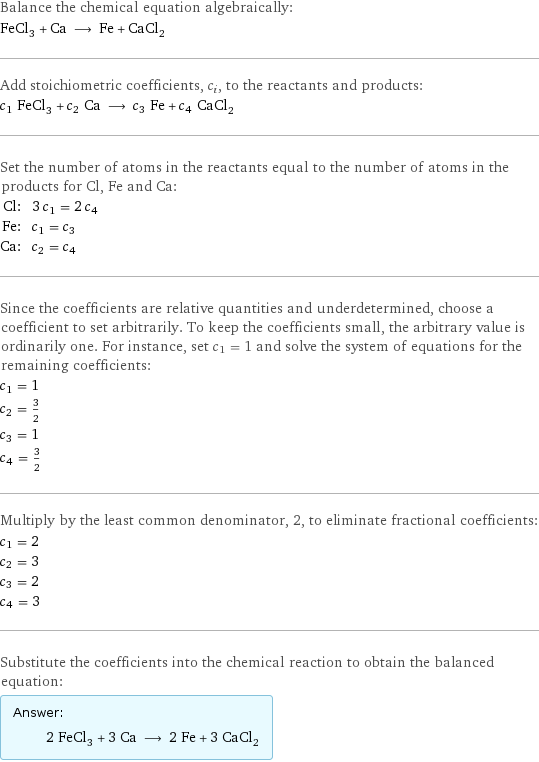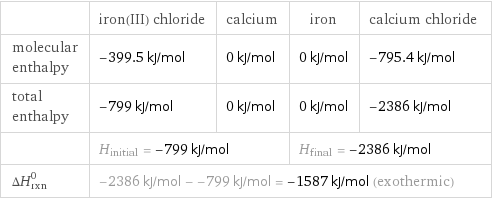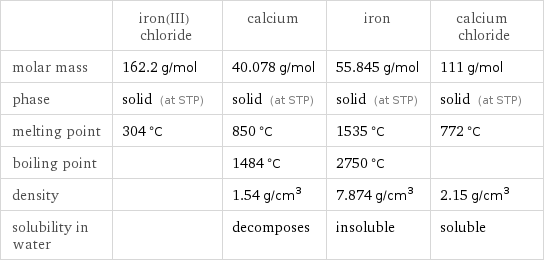Input interpretation

FeCl_3 iron(III) chloride + Ca calcium ⟶ Fe iron + CaCl_2 calcium chloride
Balanced equation

Balance the chemical equation algebraically: FeCl_3 + Ca ⟶ Fe + CaCl_2 Add stoichiometric coefficients, c_i, to the reactants and products: c_1 FeCl_3 + c_2 Ca ⟶ c_3 Fe + c_4 CaCl_2 Set the number of atoms in the reactants equal to the number of atoms in the products for Cl, Fe and Ca: Cl: | 3 c_1 = 2 c_4 Fe: | c_1 = c_3 Ca: | c_2 = c_4 Since the coefficients are relative quantities and underdetermined, choose a coefficient to set arbitrarily. To keep the coefficients small, the arbitrary value is ordinarily one. For instance, set c_1 = 1 and solve the system of equations for the remaining coefficients: c_1 = 1 c_2 = 3/2 c_3 = 1 c_4 = 3/2 Multiply by the least common denominator, 2, to eliminate fractional coefficients: c_1 = 2 c_2 = 3 c_3 = 2 c_4 = 3 Substitute the coefficients into the chemical reaction to obtain the balanced equation: Answer: | | 2 FeCl_3 + 3 Ca ⟶ 2 Fe + 3 CaCl_2
Structures

+ ⟶ +
Names

iron(III) chloride + calcium ⟶ iron + calcium chloride
Reaction thermodynamics
Enthalpy

| iron(III) chloride | calcium | iron | calcium chloride molecular enthalpy | -399.5 kJ/mol | 0 kJ/mol | 0 kJ/mol | -795.4 kJ/mol total enthalpy | -799 kJ/mol | 0 kJ/mol | 0 kJ/mol | -2386 kJ/mol | H_initial = -799 kJ/mol | | H_final = -2386 kJ/mol | ΔH_rxn^0 | -2386 kJ/mol - -799 kJ/mol = -1587 kJ/mol (exothermic) | | |
Equilibrium constant
![Construct the equilibrium constant, K, expression for: FeCl_3 + Ca ⟶ Fe + CaCl_2 Plan: • Balance the chemical equation. • Determine the stoichiometric numbers. • Assemble the activity expression for each chemical species. • Use the activity expressions to build the equilibrium constant expression. Write the balanced chemical equation: 2 FeCl_3 + 3 Ca ⟶ 2 Fe + 3 CaCl_2 Assign stoichiometric numbers, ν_i, using the stoichiometric coefficients, c_i, from the balanced chemical equation in the following manner: ν_i = -c_i for reactants and ν_i = c_i for products: chemical species | c_i | ν_i FeCl_3 | 2 | -2 Ca | 3 | -3 Fe | 2 | 2 CaCl_2 | 3 | 3 Assemble the activity expressions accounting for the state of matter and ν_i: chemical species | c_i | ν_i | activity expression FeCl_3 | 2 | -2 | ([FeCl3])^(-2) Ca | 3 | -3 | ([Ca])^(-3) Fe | 2 | 2 | ([Fe])^2 CaCl_2 | 3 | 3 | ([CaCl2])^3 The equilibrium constant symbol in the concentration basis is: K_c Mulitply the activity expressions to arrive at the K_c expression: Answer: | | K_c = ([FeCl3])^(-2) ([Ca])^(-3) ([Fe])^2 ([CaCl2])^3 = (([Fe])^2 ([CaCl2])^3)/(([FeCl3])^2 ([Ca])^3)](../image_source/9a27a8df64d5a4916ca5024f052ec12e.png)
Construct the equilibrium constant, K, expression for: FeCl_3 + Ca ⟶ Fe + CaCl_2 Plan: • Balance the chemical equation. • Determine the stoichiometric numbers. • Assemble the activity expression for each chemical species. • Use the activity expressions to build the equilibrium constant expression. Write the balanced chemical equation: 2 FeCl_3 + 3 Ca ⟶ 2 Fe + 3 CaCl_2 Assign stoichiometric numbers, ν_i, using the stoichiometric coefficients, c_i, from the balanced chemical equation in the following manner: ν_i = -c_i for reactants and ν_i = c_i for products: chemical species | c_i | ν_i FeCl_3 | 2 | -2 Ca | 3 | -3 Fe | 2 | 2 CaCl_2 | 3 | 3 Assemble the activity expressions accounting for the state of matter and ν_i: chemical species | c_i | ν_i | activity expression FeCl_3 | 2 | -2 | ([FeCl3])^(-2) Ca | 3 | -3 | ([Ca])^(-3) Fe | 2 | 2 | ([Fe])^2 CaCl_2 | 3 | 3 | ([CaCl2])^3 The equilibrium constant symbol in the concentration basis is: K_c Mulitply the activity expressions to arrive at the K_c expression: Answer: | | K_c = ([FeCl3])^(-2) ([Ca])^(-3) ([Fe])^2 ([CaCl2])^3 = (([Fe])^2 ([CaCl2])^3)/(([FeCl3])^2 ([Ca])^3)
Rate of reaction
![Construct the rate of reaction expression for: FeCl_3 + Ca ⟶ Fe + CaCl_2 Plan: • Balance the chemical equation. • Determine the stoichiometric numbers. • Assemble the rate term for each chemical species. • Write the rate of reaction expression. Write the balanced chemical equation: 2 FeCl_3 + 3 Ca ⟶ 2 Fe + 3 CaCl_2 Assign stoichiometric numbers, ν_i, using the stoichiometric coefficients, c_i, from the balanced chemical equation in the following manner: ν_i = -c_i for reactants and ν_i = c_i for products: chemical species | c_i | ν_i FeCl_3 | 2 | -2 Ca | 3 | -3 Fe | 2 | 2 CaCl_2 | 3 | 3 The rate term for each chemical species, B_i, is 1/ν_i(Δ[B_i])/(Δt) where [B_i] is the amount concentration and t is time: chemical species | c_i | ν_i | rate term FeCl_3 | 2 | -2 | -1/2 (Δ[FeCl3])/(Δt) Ca | 3 | -3 | -1/3 (Δ[Ca])/(Δt) Fe | 2 | 2 | 1/2 (Δ[Fe])/(Δt) CaCl_2 | 3 | 3 | 1/3 (Δ[CaCl2])/(Δt) (for infinitesimal rate of change, replace Δ with d) Set the rate terms equal to each other to arrive at the rate expression: Answer: | | rate = -1/2 (Δ[FeCl3])/(Δt) = -1/3 (Δ[Ca])/(Δt) = 1/2 (Δ[Fe])/(Δt) = 1/3 (Δ[CaCl2])/(Δt) (assuming constant volume and no accumulation of intermediates or side products)](../image_source/c72f56b1e517c6143dd16bbe86b3376c.png)
Construct the rate of reaction expression for: FeCl_3 + Ca ⟶ Fe + CaCl_2 Plan: • Balance the chemical equation. • Determine the stoichiometric numbers. • Assemble the rate term for each chemical species. • Write the rate of reaction expression. Write the balanced chemical equation: 2 FeCl_3 + 3 Ca ⟶ 2 Fe + 3 CaCl_2 Assign stoichiometric numbers, ν_i, using the stoichiometric coefficients, c_i, from the balanced chemical equation in the following manner: ν_i = -c_i for reactants and ν_i = c_i for products: chemical species | c_i | ν_i FeCl_3 | 2 | -2 Ca | 3 | -3 Fe | 2 | 2 CaCl_2 | 3 | 3 The rate term for each chemical species, B_i, is 1/ν_i(Δ[B_i])/(Δt) where [B_i] is the amount concentration and t is time: chemical species | c_i | ν_i | rate term FeCl_3 | 2 | -2 | -1/2 (Δ[FeCl3])/(Δt) Ca | 3 | -3 | -1/3 (Δ[Ca])/(Δt) Fe | 2 | 2 | 1/2 (Δ[Fe])/(Δt) CaCl_2 | 3 | 3 | 1/3 (Δ[CaCl2])/(Δt) (for infinitesimal rate of change, replace Δ with d) Set the rate terms equal to each other to arrive at the rate expression: Answer: | | rate = -1/2 (Δ[FeCl3])/(Δt) = -1/3 (Δ[Ca])/(Δt) = 1/2 (Δ[Fe])/(Δt) = 1/3 (Δ[CaCl2])/(Δt) (assuming constant volume and no accumulation of intermediates or side products)
Chemical names and formulas

| iron(III) chloride | calcium | iron | calcium chloride formula | FeCl_3 | Ca | Fe | CaCl_2 Hill formula | Cl_3Fe | Ca | Fe | CaCl_2 name | iron(III) chloride | calcium | iron | calcium chloride IUPAC name | trichloroiron | calcium | iron | calcium dichloride
Substance properties

| iron(III) chloride | calcium | iron | calcium chloride molar mass | 162.2 g/mol | 40.078 g/mol | 55.845 g/mol | 111 g/mol phase | solid (at STP) | solid (at STP) | solid (at STP) | solid (at STP) melting point | 304 °C | 850 °C | 1535 °C | 772 °C boiling point | | 1484 °C | 2750 °C | density | | 1.54 g/cm^3 | 7.874 g/cm^3 | 2.15 g/cm^3 solubility in water | | decomposes | insoluble | soluble
Units
